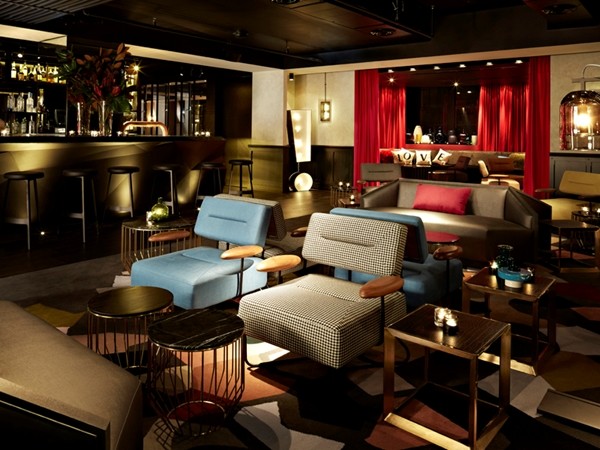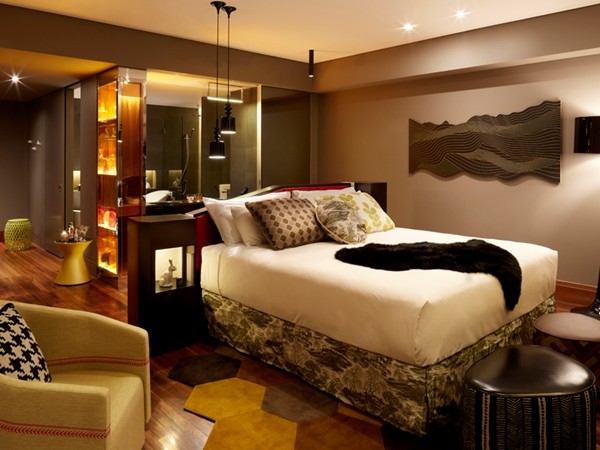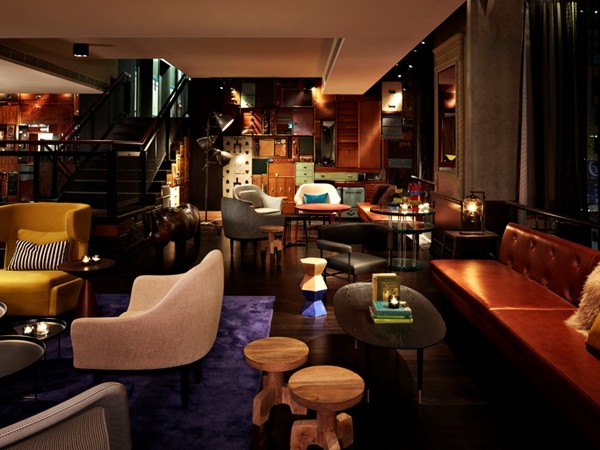With a brief of ‘a hotel like no other’, PointOfView were tasked with the lighting design throughout QT Sydney to enhance the excitement of the dynamic space created by interior designers Indyk Architects + Nic Graham Associates.
Located in the heart of the city on Market St, the hotel needed to be a landmark project, enticing non-residents to have a drink in the bar or a meal in the restaurant.
Inspiration for the lighting design of the QT came from the interior design and architecture of the building, POV principal Mark Elliott explains.
“This, together with the mood required for the spaces inspires our approach. It directs where we focus light, which features we enhance and which products we use to deliver the concept,” Elliott says.
Style is very much intentional, he says, with more of a European or American designed hotel feel. The design follows the principles set out by Ian Schragers Hotels in the late 90s, such as St Martins Lane Hotel, London or the Hudson Hotel, NYC.
“Each object is designed. Nothing is left to chance, but it has an effortless presentation.”

Working closely with the interior design team, POV ensured the lighting was an integral part of the space.
“Our involvement during the conceptual stage is critical to ensure light is considered from the inception,” he says.
Being involved from the beginning allows the lighting design to be considered in connection with joinery and architectural elements. Point Of View were able to advise on how various finishes throughout the hotel had an effect on the ambience, whether they were light or dark, smooth or textured.
The custom lighting elements for the hotel were worked through in tandem with the designers during the conceptual phase and technical advice with regards to lamp types, wattages and colour temperature were discussed, Elliott says.

As lighting designers, the light source is the most critical, Elliott explains, this is what delivers the lit effect. A product which can house the requirements is then found.
“Often products are chosen on their appearance and not their function. We have to find the balance between form and function.”
As a heritage listed building, certain elements had to be retained and designed into the modernisation of the hotel. This ultimately drove the specification of surface-mounted equipment, making a feature of some light elements.
One of these elements was located within the spa rooms where a glazed ceiling panel which needed to be backlit but no access was available, Elliot explains. Side-emitting fibre optic cables which have remote light sources were used as they could be located outside of the ceiling void.

Additionally a product display shelf in guest rooms screen the rooms from the bathrooms. As a light-weight structure, it didn’t allow for traditional lighting such as spot lights, yet each shelf needed to be illuminated. Working with Indyk, edge-lit shelves that illuminated the products from below were used without any apparent light source, all within a 10mm structure.
Energy usage is a driving force behind lighting design, Elliott says, with Point Of View approaching sustainability through sustainable design rather than sustainable products.
“This means we are not wasteful with light. We use it where necessary. Equally we use darkness with powerful effect. It provides contrast and costs nothing, and uses no energy not to light a space,” he says.
“As with every project, LED plays a huge part within our specifications, but it is mixed with halogen to ensure the right ambience is achieved,” Elliott concludes.

Feature and architectural lighting illuminate QT Sydney
Two categories of lighting products were used throughout the QT Sydney - feature lighting and architectural lighting.
Most of the feature lighting was custom-made by Nocturnal Lighting and Light Force. It works as part of the furniture of the space, adding to, and complementing the overall aesthetic, Elliott says.
The architectural lighting provides ambience, enhancing feature elements and driving orientation of the guests and their behaviour within the space. Architectural spotlights were supplied by Masson with downlights from Euroluce.
LED strip lights were supplied by LiteSource and the cold cathode lighting used in many of the ceiling coves supplied by Adam Signs.
On these, Elliott says, “Each product was chosen based on the principles of good glare control, minimal and simple design language, beam angles that provide well controlled beams of light, and excellent colour rendering and appearance.”
As the use of space changes throughout the day, so does the lighting. At breakfast the lighting has the spaces feeling light and open, while dinner is very intimate.
A Dynalite Control System automatically controls this transition via an astrological time clock, which calculates sunrise and sunset everyday, Elliott says.


